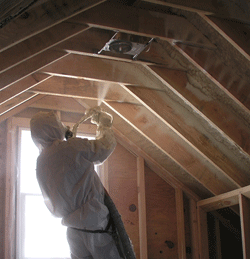Insulation for Mesa Attic Spaces

In Your Home
There are two common ways to insulate your attic space and protect your home from other weather and moisture related damages using spray polyurethane foam.
Building Science
Attic Spray Foam Insulation Application (Through a Vented Attic)
Building science and design principles that your builder/architect subscribes to can often dictate the method of spray foam used in the attic. Insulation is used on the attic floor to insulate the ceiling from the seasonal cold and/or heat in a traditional vented attic setting. Between the floor joists, where cellulose and fiberglass insulation is traditionally used, spray foam is also applied. However, no insulation is applied to the rest of the attic. The attic, via soffit, ridge, and gable vents, remains highly vented. Although it is not the most effective system, it is the most common engineered system used throughout the U.S..
Building Science (New Technology)
Attic Floor Spray
Foam Insulation Application (Through a Non-vented Attic)
This is considered the most effective application by members of the spray foam industry because it effectively seals off and insulates the entire attic space from any air infiltration. The air barrier is created by applying foam directly in between the joists, on the gable wall ends, and down around the rim and into the soffits of the underside of the roof.
The traditional practice of insulating the underside of the roof in the attic has raised much debate in the building industry because "standard" roofing and design techniques call for the attic to be ventilated in order to reduce moisture problems and heat build-up in the hot summer months.
However, inside a vented attic, it will get up to approximately 140-degrees in the summer. There's no reason for your air-conditioning and vent-ductwork to have to work in that type of severe condition. There is also opportunity for moisture to form due to condensation on these appliances.
 To achieve
insulation of the attic space from the extreme heat that radiates through the roof, the
sheathing, and the shingles, spray foam needs to be applied directly to the underside of the
roof deck. This provides the attic with the type of insulation that blocks out severe
temperatures. The attic then becomes as comfortable as any other room in the house, since it
is now a "semi-conditioned" space.
To achieve
insulation of the attic space from the extreme heat that radiates through the roof, the
sheathing, and the shingles, spray foam needs to be applied directly to the underside of the
roof deck. This provides the attic with the type of insulation that blocks out severe
temperatures. The attic then becomes as comfortable as any other room in the house, since it
is now a "semi-conditioned" space.
It is argued that this system can cause the shingles on your roof to overheat and curl off. According to designers and builders, the reason for this happening is because wood needs to breathe.
An example of why "breathing wood" issue is not much of an issue can be found in the furniture industry. Most manufacturers actually kiln dry wood before it is used. Through extensive research, we learned that manufacturers claim that wood can deteriorate faster if it is allowed to "breathe". Kiln dry wood contains a small amount of moisture and it is used in all furniture. That moisture generates cracks and splits as it continues to dry out. Manufacturers know that wood must be totally sealed so they will take extra precautions to make sure that the wood is completely sealed. The same is true of the wooden shingles on your roof and SPF insulation.
Spray foam reduces energy consumption in several ways when it is applied on a roof. It can essentially eliminate energy loss from ducts located in the attic. With less infiltration and exfiltration, excess moisture isn't pulled into the attic since the top of the building is much tighter. Spray foam also reduces infiltration through the ceiling. It reduces energy consumption because the temperature in the attic is lower.
During the summer, standard ceiling insulation reduces the transfer of heat from the attic to the living space. In the day, temperatures can get up to 140F in the attic. There is a multi-step process from which heats enters the attic space. Initially, the shingles and sheathing are battered down with heat from solar energy. Then, heat is transferred to the rest of the attic through convection and conduction derived from hot sheathing. The heat transfer process is driven by the 140F temperature of the underside of the roof surface.
Applying spray foam insulation to the roof surface can cause an approximate 40F reduction of the temperature driving the heat transfer, which is the surface temperature exposed to the attic. Heat transfer is reduced proportional to a drop in the surface temperature, since heat transfer in both convection and conduction are proportional to a temperature difference.

What can spray foam do for your Mesa home or building?
- Stops air / moisture leakage
- Reduces drafts
- Save on energy costs
- Reduce monthly utility bills
- Keeps dust and pollen out
- Strengthens structures (CC)
- Reduces Noise Infiltration (OC)
Navigation
Areas of SERVICE
Our Mesa spray foam contractors provide high-quality spray foam insulation services for residential and commercial applications and foam roofing services for industrial and commercial buildings near and throughout Arizona. We offer competitive spray foam insulation pricing in AZ and ultimately help you save money on utility bills.
Call us today at 855-GET-FOAM(438-3626) for a free quote or estimate.
